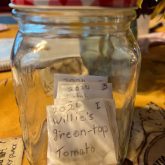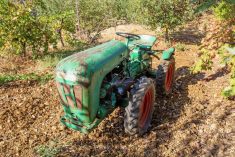Not that it is a major news blast, but if they haven’t done so already western Canadian farmers need to be thinking now about getting seed sources lined up for the 2022 growing season. Also, if they’re planning to use farm-saved seed, make sure it is properly tested for germination and vigour.
The 2021 growing season was a tough year in many respects. Drought conditions certainly reduced yields in many areas and of many crops, so in many cases the amount of certified seed available for the coming year will be reduced. The key message from seed suppliers is be prepared to be flexible. If one crop type or variety isn’t available, be prepared to switch to something else.
Also, those dry conditions took its toll on some aspects of seed quality. With pulse crops, for example, and with peas, more specifically, the dryness made them more susceptible to handling damage (there was a lot of cracked seed), and that can affect germination.
Read Also

Cancer agency reclassifies another herbicide ‘probably carcinogenic’
The WHO’s cancer research agency has now put atrazine, a herbicide well known to corn growers, in the same potential-hazard category where the agency put glyphosate.
Especially if you’re planning to use homegrown or bin-run seed of any crop type this year, experts strongly recommend it be properly tested for both germination and vigour.
Looking at the supply side
With a snapshot on the certified seed supply situation, Todd Hyra, Western Canada business manager for SeCan based in Winnipeg, says seed supplies vary widely depending on the crop, the variety and the region. Describing itself as Canada’s largest supplier of certified seed, SeCan member companies distribute dominant varieties of wheat, soybeans, barley, oats, flax and forages.

“Generally, with spring wheat varieties the supply is very good across Western Canada,” says Hyra. “Wheat seemed to handle the drought much better than some other seed crops. At this stage, you might not find a particular variety available, but your seed retailer will be able to find you something.”
On the other end of the supply scale, yellow peas, in particular, may be hard to find, Hyra says.
“Yield-wise they didn’t do as well with the dry conditions and because it was so dry they were more susceptible to damage during handling,” he says. “Yellow pea supplies are tight, but also seed of other large, pulse crop types such as soybeans and large lentils are limited this year as well.”
So those are the two ends of the supply situation, with the rest of the major crop types somewhere in the middle, says Hyra.
Durum wheat seed supplies are not too bad, although if producers are looking for solid stem varieties with resistance to sawfly, those may be in short supply. “There may be seed available in some spots across Western Canada, but supplies are limited,” says Hyra. “Again, it is a matter of checking with your local grower to see what they can do for you.”
Hyra says farmers planning to buy good-quality, certified seed need to look for the blue tag of quality assurance.
Certified seed, as explained by the Canadian Seed Growers’ Association, is recognizable by the blue “certified” tag of the Canadian Food Inspection Agency that accompanies each sale of seed.
This tag means the seed and crop have been inspected by an officially recognized third-party agency, have been produced by dedicated Canadian seed growers according to stringent requirements, have undergone a carefully monitored production process, have passed the quality assurance requirements of varietal purity, germination and freedom from impurities, and the seed is ready for commercial use.
“There are a few opportunists out there who may say they have certified seed available, but unless it has the blue tag it isn’t certified seed,” says Hyra.
He also cautions producers when buying common seed to make sure they are not breaking the law covered by plant breeders’ rights (PBR).

There are three particular rules producers need to be aware of when it comes to buying common seed. If they are buying an older variety where the PBR has expired that is totally legal.
However there are crop varieties covered by both old and newer PBR legislation — the older is known as PBR 78 and the newer legislation is PBR 91.
“It is illegal for anyone to sell any crop varieties covered by PBR 78 without paying royalties,” says Hyra. “And with the newer legislation PBR 91, it is illegal for both the seller and the buyer to be involved in a sales transaction of crop varieties covered by that legislation.” For more details on legal requirements visit the PBR website at pbrfacts.ca/farmers.
And on a final note to seed buyers, Hyra warns farmers to be prepared for sticker price shock. With commodity prices exceptionally high in 2021, seed prices have followed suit.
“If commodity oats are $10 per bushel, for example, then the certified seed is going to be $10 plus seed growers’ costs, such as the cost of cleaning, royalties and grower margin,” says Hyra. “Farmers need to be prepared for that. Seed growers can’t sell seed for the same as commodity prices.”
What about the quality situation?
The story on seed quality is much like the supply situation, says Rachael Melenka, client success manager at 20/20 Seed Labs in Nisku, Alta.

“Generally, as we look at the testing of seed samples from across Western Canada, cereal seed quality is quite good,” says Melenka. The lab’s germination and vigour testing of seed samples includes wheat, barley, oats, durum, triticale and rye.
“In previous years with adverse weather during harvest, we’ve seen some deeper quality issues such as dormancy and frost damage, but there is no evidence of that this year,” she says. “We are seeing both good germination and vigour in this year’s samples.”
It’s a different story for several of the pulse crops, however. “Germination and vigour have been affected by damage to pulse crop seeds,” says Melenka. Field peas, lentils, faba bean and soybeans have all been affected by mechanical damage during harvest and storage. Extremely dry conditions during the growing season and at harvest along with a period of extremely cold conditions for a few weeks early in the winter contributed to increased levels of seed cracking.
Melenka recommends if pulse seed crops were tested for germination and vigour shortly after harvest or earlier this winter that they be tested again before seeding to ensure seed quality hasn’t declined.
Seed testing of the 2021 crop did show some degree of chemical damage on samples, she says. It most likely happened in areas where August rainfall caused a flush of new growth and increased tillering in some crops and farmers were forced to desiccate fields saved for seed to control the green growth and even out crop maturity. Again, her recommendation is if a desiccant was applied last fall, seed from those crops should be tested for germination and vigour before seeding.
The seed testing lab has also changed a recommendation regarding testing cereal seed for disease ahead of the 2022 seeding season.
Because of the dry growing conditions, there was lower incidence of fusarium head blight (FHB) on cereal crops and 20/20 Seed Labs has a couple of disease-testing methods available for detecting Fusarium graminearum — the plate method and the DNA test method.
“This year we are recommending farmers opt for the DNA testing as it is a much more sensitive test and can detect lower levels of Fusarium graminearum infection in and on seed,” says Melenka.
Is it OK to use seed that tests positive for F. graminearum? Here are a couple of recommendations. If a grower is in an area that has never had FHB, it is suggested they maintain zero tolerance for F. graminearum on seed batches. If it isn’t present in your area, keep it that way — don’t use seed even with a low level of infection.
If a farmer is growing a cereal in an area known to have FHB, it is recommended using seed that tests five per cent or lower for F. graminearum, which is acceptable but requires elevated management such as use of a seed treatment.
“However, if the seed sample is showing upwards of seven to 10 per cent F. graminearum infection, we would recommend the farmer find another seed source,” says Melenka.
Among pulse crop testing, one positive effect of the dry growing season was reduced levels of ascochyta blight, says Melenka.
“Of the samples we have tested, about 22 per cent are testing positive for ascochyta, which is still significant,” she says. “But it is the lowest level of infection we have seen since 2007 when we first began collecting data on the disease. We would still recommend producers apply a seed treatment to control the disease.”
A few management tips

Dale Risula, a provincial specialist for pulse and other speciality crops for Saskatchewan Agriculture also encourages producers to line up seed supplies as soon as possible and buy seed from a reputable seller.
He reminds producers about the new tool developed by the Saskatchewan Seed Growers’ Association called the Interactive SaskSeed Guide or visit ‘The great 2022 seed scramble.’ This and other online tools can help producers track down available varieties.
Risula says if farmers are planning to use farm-saved seed for 2022, it is important to have it tested before seeding to ensure key quality factors are there. “Even if the seed batch was tested last fall or in early winter, quality changes can occur in storage,” he says. “A proper germination and vigour test should be made again before seeding.”
Risula says if germination levels are lower than 85 to 90 per cent, the seed can still be used by increasing the seeding rate. “Seeding a bit heavier is fine,” he says. “But just make sure the seed batch is free of weed seed and disease to make sure a higher seeding rate doesn’t also increase weed population and disease levels. A seed treatment is recommended.”
Also, if using a seed batch with slightly lower germination and vigour, he urges farmers to pay attention to the amount of fertilizer placed in the seed row, as higher rates could damage seedlings with lower vigour. Additionally, with lower germination and vigour seed batches, he recommends a shallow seed depth, making it easier for the seedlings to emerge and get growing.
















